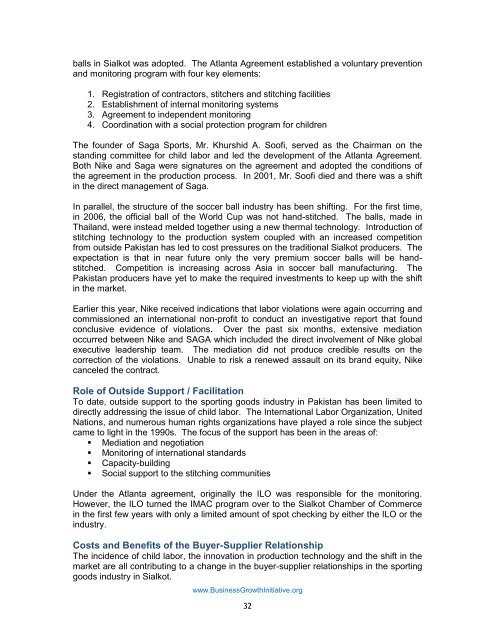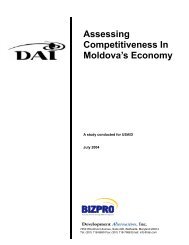the ties that bind - Economic Growth - usaid
the ties that bind - Economic Growth - usaid
the ties that bind - Economic Growth - usaid
You also want an ePaper? Increase the reach of your titles
YUMPU automatically turns print PDFs into web optimized ePapers that Google loves.
alls in Sialkot was adopted. The Atlanta Agreement established a voluntary prevention<br />
and monitoring program with four key elements:<br />
1. Registration of contractors, stitchers and stitching facili<strong>ties</strong><br />
2. Establishment of internal monitoring systems<br />
3. Agreement to independent monitoring<br />
4. Coordination with a social protection program for children<br />
The founder of Saga Sports, Mr. Khurshid A. Soofi, served as <strong>the</strong> Chairman on <strong>the</strong><br />
standing committee for child labor and led <strong>the</strong> development of <strong>the</strong> Atlanta Agreement.<br />
Both Nike and Saga were signatures on <strong>the</strong> agreement and adopted <strong>the</strong> conditions of<br />
<strong>the</strong> agreement in <strong>the</strong> production process. In 2001, Mr. Soofi died and <strong>the</strong>re was a shift<br />
in <strong>the</strong> direct management of Saga.<br />
In parallel, <strong>the</strong> structure of <strong>the</strong> soccer ball industry has been shifting. For <strong>the</strong> first time,<br />
in 2006, <strong>the</strong> official ball of <strong>the</strong> World Cup was not hand-stitched. The balls, made in<br />
Thailand, were instead melded toge<strong>the</strong>r using a new <strong>the</strong>rmal technology. Introduction of<br />
stitching technology to <strong>the</strong> production system coupled with an increased competition<br />
from outside Pakistan has led to cost pressures on <strong>the</strong> traditional Sialkot producers. The<br />
expectation is <strong>that</strong> in near future only <strong>the</strong> very premium soccer balls will be handstitched.<br />
Competition is increasing across Asia in soccer ball manufacturing. The<br />
Pakistan producers have yet to make <strong>the</strong> required investments to keep up with <strong>the</strong> shift<br />
in <strong>the</strong> market.<br />
Earlier this year, Nike received indications <strong>that</strong> labor violations were again occurring and<br />
commissioned an international non-profit to conduct an investigative report <strong>that</strong> found<br />
conclusive evidence of violations. Over <strong>the</strong> past six months, extensive mediation<br />
occurred between Nike and SAGA which included <strong>the</strong> direct involvement of Nike global<br />
executive leadership team. The mediation did not produce credible results on <strong>the</strong><br />
correction of <strong>the</strong> violations. Unable to risk a renewed assault on its brand equity, Nike<br />
canceled <strong>the</strong> contract.<br />
Role of Outside Support / Facilitation<br />
To date, outside support to <strong>the</strong> sporting goods industry in Pakistan has been limited to<br />
directly addressing <strong>the</strong> issue of child labor. The International Labor Organization, United<br />
Nations, and numerous human rights organizations have played a role since <strong>the</strong> subject<br />
came to light in <strong>the</strong> 1990s. The focus of <strong>the</strong> support has been in <strong>the</strong> areas of:<br />
Mediation and negotiation<br />
Monitoring of international standards<br />
Capacity-building<br />
Social support to <strong>the</strong> stitching communi<strong>ties</strong><br />
Under <strong>the</strong> Atlanta agreement, originally <strong>the</strong> ILO was responsible for <strong>the</strong> monitoring.<br />
However, <strong>the</strong> ILO turned <strong>the</strong> IMAC program over to <strong>the</strong> Sialkot Chamber of Commerce<br />
in <strong>the</strong> first few years with only a limited amount of spot checking by ei<strong>the</strong>r <strong>the</strong> ILO or <strong>the</strong><br />
industry.<br />
Costs and Benefits of <strong>the</strong> Buyer-Supplier Relationship<br />
The incidence of child labor, <strong>the</strong> innovation in production technology and <strong>the</strong> shift in <strong>the</strong><br />
market are all contributing to a change in <strong>the</strong> buyer-supplier relationships in <strong>the</strong> sporting<br />
goods industry in Sialkot.<br />
www.Business<strong>Growth</strong>Initiative.org<br />
32

















